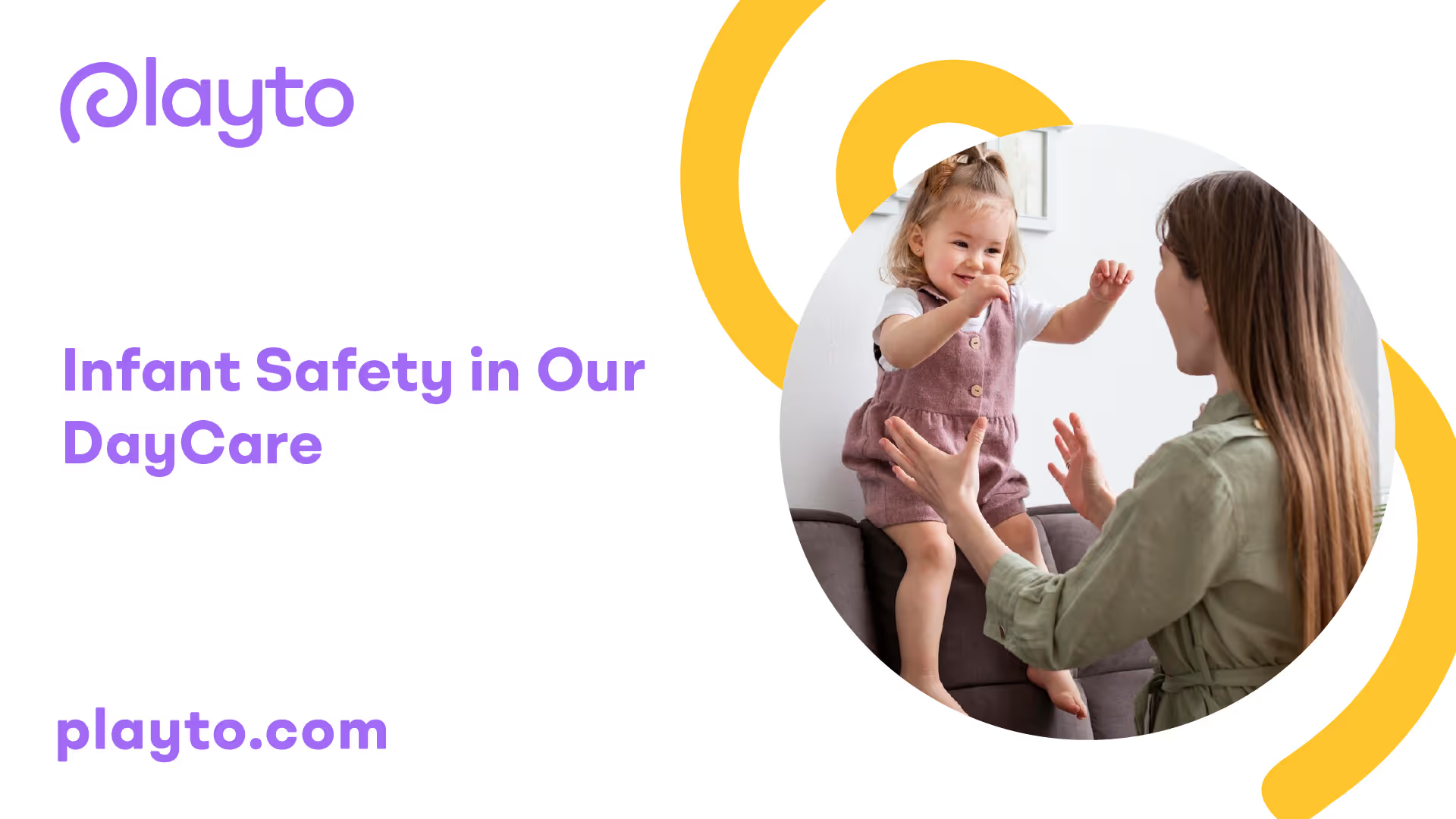
Importance of Safety
Overview of Infant Safety
Ensuring the safety of infants in daycare settings is of utmost importance. Injuries are the leading cause of death and disability for young children. Specific risks can vary by age, with toddlers being particularly susceptible to poisoning, while preschoolers face risks associated with drowning and school-aged children are more prone to pedestrian accidents. The majority of childhood injuries are preventable, emphasizing the necessity for daycares to adopt specific preventive measures.
Implementing safety protocols, training staff adequately, and maintaining a vigilant environment are essential components of infant safety in daycare. These measures not only protect the well-being of the children but also provide reassurance to parents. For more information on the advantages of daycare for infants, consider reading about the benefits of daycare for infants.
Risks in Daycare Settings
Daycare environments pose unique safety challenges that must be addressed. The most frequent accidents among children in these settings are falls, which can lead to various injuries. Moreover, serious incidents often arise from children swallowing small parts or inserting tiny toys into their noses or ears.
To better understand the risks, here is a summary of common hazards in daycare settings:
Type of Risk Description
- Falls: The most common type of accident among children.
- Choking: Small toys or parts pose a choking hazard.
- Drowning: High risk around water features; second leading cause of injury-related death for children under 15.
- Poisoning: Young children are especially vulnerable to poisoning.
Close supervision is critical to preventing injuries, as many incidents occur when children are out of sight for just a few minutes. Daycare providers must implement stringent supervision protocols to minimize risks. For guidance on selecting the right infant daycare, explore our article on choosing the right infant daycare.
Overall, recognizing and addressing these risks is key to establishing a safe environment for infants in daycare settings.

Emergency Preparedness
Emergency preparedness is a vital component of maintaining infant safety in our daycare. In childcare settings, children are particularly vulnerable during emergencies. They may not fully understand or cope with the situation, making it essential for caregivers to have a thorough plan in place.
Planning for Emergencies
Creating a comprehensive emergency plan is crucial for ensuring the safety of infants in a daycare environment. This plan should include:
- Evacuation Procedures: Clearly outlined steps for evacuating the building in case of a fire or other emergency.
- Shelter-in-Place Procedures: Guidelines for situations where it may be safer to stay indoors, such as severe weather.
- Emergency Contacts: A list of emergency contacts, including parents, local authorities, and medical services.
An emergency kit should also be assembled, containing essential supplies like first aid items, water, non-perishable food, and flashlights. Staying informed about potential dangers, such as severe weather or nearby construction, is also essential for maintaining a safe environment.
Emergency Preparedness Component Details
- Evacuation Procedures: Steps for safely exiting the premises.
- Shelter-in-Place Procedures: Guidelines for remaining indoors during emergencies.
- Emergency Contacts: List of essential contacts, including parents and authorities.
Involving Children in Drills
Involving children in emergency drills is a key aspect of effective preparedness. Familiarizing them with emergency procedures enables them to react appropriately during actual crises. Experience with practice drills can significantly enhance their ability to cope with emergency situations.
Communication plays a crucial role in this process. Clear instructions should be provided to children in a way that they can understand, ensuring that they know what to expect during an emergency. This can help reduce anxiety and confusion when real emergencies occur. Regularly scheduled drills, such as fire drills or lockdown drills, should be conducted to reinforce these procedures.
Type of Drill Frequency
- Fire Drills: Monthly
- Shelter-in-Place Drills: Quarterly
- Lockdown Drills: Bi-Annually
By integrating emergency preparedness into the daycare routine, staff can foster a culture of safety that empowers both caregivers and children. This proactive approach not only enhances the safety of children but also provides peace of mind to parents, knowing that their infants are cared for in a well-prepared environment. For more insights on selecting a daycare, refer to our article on choosing the right infant daycare.

Licensing and Regulations
Child Care Licensing Explained
Child care licensing is a crucial process mandated by federal law that requires states and territories to establish and enforce minimum health and safety requirements for child care programs. This regulation aims to ensure the safety and well-being of children in daycare settings. Licensed child care programs are monitored regularly to confirm they continue to meet these health and safety standards, although it is important to note that licensing does not guarantee the overall quality of care provided.
One significant aspect of child care licensing is the requirement for state and federal criminal background checks, which include fingerprint checks for all staff in licensed programs. This measure is designed to enhance safety within daycare environments, ensuring that individuals who work with infants have undergone thorough vetting.
Licensing Aspect Description
- Health and Safety Standards: Minimum requirements set by the state to protect children.
- Monitoring: Regular inspections to ensure compliance with standards.
- Background Checks: Mandatory criminal checks for all staff members.
Compliance and Inspections
Compliance with licensing regulations is vital for maintaining a safe environment in daycare settings. Child care licensing inspectors are responsible for reviewing specific health and safety rules that programs must follow to protect children's well-being. This includes ensuring proper supervision, safe facilities, and appropriate emergency procedures.
Despite the importance of these inspections, data indicates that across 41 states in the U.S., one in ten licensed daycare facilities is overdue for an inspection, which may pose potential risks to infant safety due to non-compliance with safety standards [6]. Furthermore, approximately 43% of inspections uncover compliance issues, which may include serious concerns like hazardous materials or insufficient supervision, directly impacting the safety of infants in daycare environments.
Compliance Issue Percentage of Inspections
- Overdue for Inspection: 10%
- Inspections with Compliance Issues: 43%
Understanding the importance of licensing and the rigorous compliance checks can help parents make informed decisions regarding daycare options. For more insights on choosing the right facility, explore our article on choosing the right infant daycare.
Supervision and Ratios
Ensuring proper supervision and maintaining appropriate staff-to-child ratios are fundamental aspects of promoting infant safety in our daycare. These measures help create a secure environment where infants can thrive and develop.
Staff-to-Child Ratios
Staff-to-child ratios are regulated to ensure that each infant receives adequate attention and supervision. These ratios are essential for maintaining the health and safety of children in care. According to Childcare.gov, specific guidelines dictate the maximum number of infants one caregiver can supervise, which varies by age group.
Age Group Recommended Staff-to-Child Ratio
- Infants (0-12 months): 1:3
- Toddlers (1-3 years): 1:4
- Preschoolers (3-5 years): 1:10
These ratios help ensure that caregivers can effectively monitor and respond to the needs of each child, creating a safer environment.
Importance of Close Supervision
Close supervision is critical in a daycare setting, as many incidents occur when children are out of sight for just a few moments. The risk of injuries can significantly increase without proper oversight. According to the eXtension Alliance for Better Child Care, it is essential for caregivers to remain vigilant and attentive to the children's activities at all times.
Effective supervision not only helps prevent accidents but also allows caregivers to foster a nurturing and supportive atmosphere. Clear communication between adults and children is vital for effective emergency preparedness and response [4]. By maintaining appropriate ratios and ensuring close supervision, daycare centers can enhance the overall safety and well-being of the infants in their care.
For more insights on selecting the right daycare, explore our article on choosing the right infant daycare.
Safe Environment
Creating a safe environment is critical for ensuring the well-being of infants in daycare settings. This involves carefully designing spaces for exploration and considering the safety of toys available for use.
Designing Safe Spaces
Child care environments should be designed to allow safe exploration for all ages, including infants. It is essential for infants to have a designated safe play space rather than being confined to cribs or high chairs. A well-structured play area can promote healthy development while minimizing risks.
Key elements to consider when designing safe spaces include:
- Soft surfaces: Use padded mats or carpets to cushion falls.
- Barrier-free zones: Ensure that infants can move freely without obstacles that might cause tripping.
- Clear sightlines: Arrange furniture and play equipment to allow caregivers to easily monitor infants.
Design Element Description
- Soft Surfaces: Padded mats and carpets to cushion falls
- Barrier-Free Zones: Open spaces to facilitate movement
- Clear Sightlines: Arranged furniture for easy monitoring
Toy Safety Considerations
Selecting toys with care is paramount in ensuring safety within child care environments. Proper education about the appropriate use of toys can further enhance safety. Special attention should be paid to toys specifically designed for infants and toddlers to minimize the risks associated with their use.
Important safety tips for toys include:
- Age Appropriateness: Choose toys that are suitable for the infant's age and developmental stage.
- Durability: Select toys that are sturdy and free from small parts that could be swallowed or pose choking hazards.
- Material Safety: Ensure toys are made from non-toxic materials and are free from harmful chemicals.
Toy Safety Tip Explanation
- Age Appropriateness: Select toys based on age and developmental stage
- Durability: Choose sturdy toys without small parts
- Material Safety: Ensure toys are non-toxic and safe
Falls are the most common type of accident among children in daycare settings. Serious injuries, however, often occur when children swallow small parts or insert tiny toys into their noses or ears. By fostering a safe environment through thoughtful design and careful selection of toys, daycare facilities can significantly reduce the risk of injury and promote a safe learning atmosphere.
For more information on the benefits of daycare, you can explore our article on the benefits of daycare for infants or learn about choosing the right infant daycare.
Training and Knowledge
Ensuring the safety of infants in daycare settings extends beyond just creating a secure environment. Comprehensive training and ongoing education for staff members are crucial components of maintaining high standards of care.
First Aid and CPR Training
Having staff trained in first aid and CPR is vital for any daycare environment. It is essential for parents and caregivers to have current training in pediatric first aid and to refresh CPR skills annually, as emergency treatment for young children differs from that for adults. This specialized training equips staff with the necessary skills to respond effectively to emergencies involving infants.
Training Type Key Focus Areas
- Pediatric First Aid: Recognizing and responding to common injuries and emergencies in infants
- CPR: Techniques specific to infants, including rescue breaths and chest compressions
Regular training sessions should be scheduled to ensure that all staff members maintain their certifications and stay updated on best practices in infant care.
Ongoing Staff Education
In addition to initial training, ongoing education is essential to keep staff informed about the latest safety protocols and child development practices. This continuous learning helps staff provide the highest level of care and support to infants.
Topics for ongoing education may include:
- Child safety standards
- Developmental milestones
- Nutrition and feeding practices
- Behavioral management techniques
By fostering an environment of continuous improvement, daycare facilities can enhance their overall quality of care. For parents seeking more information on selecting a daycare, resources like choosing the right infant daycare can provide valuable insights.
Investing in staff education is not only beneficial for the daycare but also reassures parents about the safety and well-being of their children. Staff members who are knowledgeable and well-trained can significantly contribute to a safe and nurturing environment for infants. To learn more about the benefits of daycare for infants, visit our article on benefits of daycare for infants.
References
- [1]: https://childcare.extension.org/preventing-injuries-in-child-care/
- [2]: https://childcare.extension.org/toy-safety-in-child-care/
- [3]: https://www.childcareed.com/a/ready-and-resilient-the-importance-of-emergency-preparedness.html
- [4]: https://info.childcareaware.org/blog/involving-children-in-child-care-emergency-preparedness
- [5]: https://childcare.gov/consumer-education/how-is-child-care-regulated
- [6]: https://usafacts.org/data-projects/childcare-inspections/
- [7]: https://www.betterhealth.vic.gov.au/health/healthyliving/child-safety-and-injury-prevention
.avif)